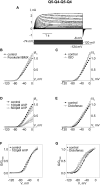Heteromeric Channels Formed From Alternating Kv7.4 and Kv7.5 α-Subunits Display Biophysical, Regulatory, and Pharmacological Characteristics of Smooth Muscle M-Currents
- PMID: 32903335
- PMCID: PMC7434985
- DOI: 10.3389/fphys.2020.00992
Heteromeric Channels Formed From Alternating Kv7.4 and Kv7.5 α-Subunits Display Biophysical, Regulatory, and Pharmacological Characteristics of Smooth Muscle M-Currents
Abstract
Smooth muscle cells of the vasculature, viscera, and lungs generally express multiple α-subunits of the Kv7 voltage-gated potassium channel family, with increasing evidence that both Kv7.4 and Kv7.5 can conduct "M-currents" that are functionally important for the regulation of smooth muscle contractility. Although expression systems demonstrate that functional channels can form as homomeric tetramers of either Kv7.4 or Kv7.5 α-subunits, there is evidence that heteromeric channel complexes, containing some combination of Kv7.4 and Kv7.5 α-subunits, may represent the predominant configuration natively expressed in some arterial myocytes, such as rat mesenteric artery smooth muscle cells (MASMCs). Our previous work has suggested that Kv7.4/Kv7.5 heteromers can be distinguished from Kv7.4 or Kv7.5 homomers based on their biophysical, regulatory, and pharmacological characteristics, but it remains to be determined how Kv7.4 and Kv7.5 α-subunits combine to produce these distinct characteristics. In the present study, we constructed concatenated dimers or tetramers of Kv7.4 and Kv7.5 α-subunits and expressed them in a smooth muscle cell line to determine if a particular α-subunit configuration can exhibit the features previously reported for natively expressed Kv7 currents in MASMCs. Several unique characteristics of native smooth muscle M-currents were reproduced under conditions that constrain channel formation to a Kv7.4:Kv7.5 stoichiometry of 2:2, with alternating Kv7.4 and Kv7.5 α-subunits within a tetrameric structure. Although other subunit arrangements/combinations are not ruled out, the findings provide new insights into the oligomerization of α-subunits and the ways in which Kv7.4/Kv7.5 subunit assembly can affect smooth muscle signal transduction and pharmacological responses to Kv7 channel modulating drugs.
Keywords: Kv7.4; Kv7.5; M-current; smooth muscle; α-subunit stoichiometry.
Copyright © 2020 Brueggemann, Cribbs and Byron.
Figures






Similar articles
-
Kv7.5 Potassium Channel Subunits Are the Primary Targets for PKA-Dependent Enhancement of Vascular Smooth Muscle Kv7 Currents.Mol Pharmacol. 2016 Mar;89(3):323-34. doi: 10.1124/mol.115.101758. Epub 2015 Dec 23. Mol Pharmacol. 2016. PMID: 26700561 Free PMC article.
-
Differential protein kinase C-dependent modulation of Kv7.4 and Kv7.5 subunits of vascular Kv7 channels.J Biol Chem. 2014 Jan 24;289(4):2099-111. doi: 10.1074/jbc.M113.527820. Epub 2013 Dec 2. J Biol Chem. 2014. PMID: 24297175 Free PMC article.
-
Functional assembly of Kv7.1/Kv7.5 channels with emerging properties on vascular muscle physiology.Arterioscler Thromb Vasc Biol. 2014 Jul;34(7):1522-30. doi: 10.1161/ATVBAHA.114.303801. Epub 2014 May 22. Arterioscler Thromb Vasc Biol. 2014. PMID: 24855057
-
Novel treatment strategies for smooth muscle disorders: Targeting Kv7 potassium channels.Pharmacol Ther. 2016 Sep;165:14-25. doi: 10.1016/j.pharmthera.2016.05.002. Epub 2016 May 11. Pharmacol Ther. 2016. PMID: 27179745 Review.
-
Kv7 Channels in Lung Diseases.Front Physiol. 2020 Jun 26;11:634. doi: 10.3389/fphys.2020.00634. eCollection 2020. Front Physiol. 2020. PMID: 32676036 Free PMC article. Review.
Cited by
-
Kv7 Channels in Cyclic-Nucleotide Dependent Relaxation of Rat Intra-Pulmonary Artery.Biomolecules. 2022 Mar 10;12(3):429. doi: 10.3390/biom12030429. Biomolecules. 2022. PMID: 35327621 Free PMC article.
-
Activation of Kv7 channels normalizes hyperactivity of the VTA-NAcLat circuit and attenuates methamphetamine-induced conditioned place preference and sensitization in mice.Mol Psychiatry. 2023 Dec;28(12):5183-5194. doi: 10.1038/s41380-023-02218-5. Epub 2023 Aug 21. Mol Psychiatry. 2023. PMID: 37604975
-
Modeling the kinetics of heteromeric potassium channels.Front Cell Neurosci. 2022 Nov 10;16:1036813. doi: 10.3389/fncel.2022.1036813. eCollection 2022. Front Cell Neurosci. 2022. PMID: 36439203 Free PMC article.
References
Grants and funding
LinkOut - more resources
Full Text Sources
Other Literature Sources

